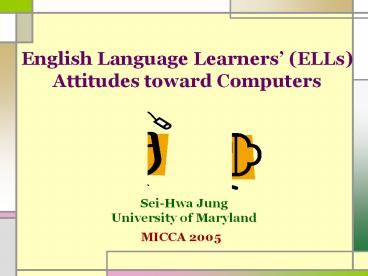English Language Learners - PowerPoint PPT Presentation
Title:
English Language Learners
Description:
Attitudes toward Computer ' ... of favorableness or unfavorableness toward computer technologies (i.e., attitude ... The success of computer systems is largely ... – PowerPoint PPT presentation
Number of Views:95
Avg rating:3.0/5.0
Title: English Language Learners
1
English Language Learners (ELLs) Attitudes
toward Computers
- Sei-Hwa Jung
- University of Maryland
MICCA 2005
2
- Attitude
- An evaluative disposition toward some object
based upon cognitions, affective reactions,
behavioral intentions, and past behaviorsthat
can influence cognitions, affective response, and
future intentions and behaviors.
(Zimbardo Leippe, 1991) - Attitudes toward Computer
- A persons general evaluation or feeling of
favorableness or unfavorableness toward computer
technologies (i.e., attitude toward objects) and
specific computer-related activities (i.e.,
attitude toward behaviors)
(Smith et al., 2000)
3
Why should we look at attitudes toward computer?
- Indicator/predictor of behaviors and behavioral
intentions (Levine, T. Donitsa-Schmidt,1998) - Attitudes influence not only the acceptance of
computers, but also future behaviors (Busch,
1995 Woodrow, 1991) - Positive, anxiety free attitude toward
computing is a necessary prerequisite of computer
literacy (Simonson et al. 1987) - The success of computer systems is largely
dependent upon the attitudes of both instructors
and students (Lawton Gerschner, 1982)
4
Theoretical Frameworks
Fishbein Ajzen (1975)s theory of reasoned
action
(Levine, T. Donitsa-Schmidt, 1998)
5
(No Transcript)
6
Research Methodology
- Quantitative (Survey)
- Questionnaires (4 or 5-point Likert-type scales)
- Stevens Computer Survey
- Reece Gables Attitudes Toward Computers,
- Gressard Loyds Computer Attitude Scales
- Griswolds Computer Use Questionnaire
- The Bath County Computer Attitude Scale
7
Computer Attitudes Scale (Loyd Gressard, 1984
Loyd Loyd, 1985)
- The most extensively used and tested scale
(Woodrow, 1991) - Achieved most popularity and use (Al-Khaldi, M.
Al-Jabri, 1998) - 40 items, a 5-point Likert-type scale
- Coefficient alpha reliabilities of 0.89, 0.89,
0.90, and .82 for the subscales, and 0.95 for the
total
8
I. Gender Computer Attitudes
- Mixed(Whitley, 1997), inconsistent (Yaghi, 1997)
and conflicting and confusing (Kay, 1992)
results - Males reported more experience in programming and
playing games, and using the computer more hours
weekly than females (Schumacher, Morahan-Martin,
2001) - Males tended to show more positive attitudes and
feel more comfortable and competent with
computers (Busch, 1995) - The social and cultural environment (Shashaani,
1997) the process of socialization (Mitra, 1998
), the lack of female role models (Young, 2000),
and peoples perceptions, attitudes and
behaviors (Shashaani, 1997)
9
II. Computer Experiences Attitudes
- Inconclusive, mixed results due to a lack of
agreement on the definition of computer
experience (Smith et al., 2000) - A positive relationship between computer
experience and computer attitudes (Al-Khaldi
Al-Jabri, 1998 Gardner et al., 1993, Levine
Donitsa-Schmidt, 1998, Pope-Davis Vispoel,
1993) - More experienced users are likely to be less
anxious and have a more positive attitude toward
the computer than less-experienced users (Mitra
Steffensmeier, 2000) - Unstructured computer experience is strongly
correlated with attitudes (Woodrow, 1994)
10
IV. Computer Ownership Attitudes
- Ownership of home computers has a positive
effects on attitudes toward computers (Casey,
Chisholm Irwin, 2002, Schumacher
Morahan-Martin, 2001 Shashaani, 1997 Yaghi,
1997) - A significant interaction between gender and
ownership (Yaghi, 1997) - It relates to economic status, parental support,
and geographic areas (Casey, Chisholm Irwin,
2002) - Home ownership of computers was also found
significant in the formation of attitudes toward
computers ? The importance of family support
(Casey, Chisholm Irwin, 2002)
11
Research Problems
- Computer is another foreign language for ELLs
- Cultural and linguistic differences
- Lack of competency (related to prior learning
experience) and comfort with computers - Lack of access to computer and the Internet at
schools and home - Little research done with ELLs on computer
attitudes and behaviors
12
School-aged English Language Learners
ELL Enrollment 2003-4 ELL Enrollment 1993-4 Change from 1993-4
Total US 5,112,081 3,552,497 43.9
Maryland 27,849 14,336 94.3
ELLs in Maryland Public Schools
Total Enrollment Growth From 93-4 ELLs Growth From 93-4
1993-4 947,520 -- 14,336 --
2003-4 847,722 -10.5 27,849 94.3
Sources U.S. Department of Education
13
Purpose of the Study
- To investigate English Language Learners
attitudes toward computers and the variables that
are significantly associated with their attitudes - What are the factors that affect computer
attitudes among English Language Learners?
14
Practical Issues Challenges
- 1. Instruments
- No single adequate instrument for ELLs
- Language problems
- Back-translation technique
- 2. Permission
- IRB from the University of Maryland
- Parents consent form
- Translation
- 3. Subject
15
The End.. Thank you!































